Dell XPS 13 Review
by Brett Howse on February 19, 2015 9:00 AM EST- Posted in
- Laptops
- Dell
- Ultrabook
- Broadwell-U
- XPS 13
System Performance
The XPS 13 is our first look at a notebook with Broadwell-U, which was launched concurrently with this and several other laptops at CES. For a complete look at the launch, check out Ian’s coverage here. The big changes with Broadwell-U over Haswell-U are two things.
First, Intel has moved to the 14nm process, refining their 3D FinFET design. This brings a lot of advantages in terms of power consumption. This is what is called a “Tick” on the Intel Tick-Tock roadmap. Ticks are die-shrinks of the previous “Tock”, which is an architecture update, in this case Haswell. Because this is basically the same CPU architecture, performance gains will be secondary to the reduction in power consumption.
Second, contrary to the CPU architecture, Intel has been iterating the GPU on every new processor. On the 15 watt Core parts, this change results in more execution units (EUs) per GPU, with the HD5500 in the XPS 13 having 23 EUs on the Core i3 model and 24 on the Core i5 and i7. The outgoing Haswell parts had only 20 EUs. This should give a slight bump in GPU power over Haswell, and there may be some other minor differences in the GPUs.
Performance Graphs
For our performance workloads, we set the device to High Performance and then run through some benchmarks to cover a wide range of workloads. For comparison, I will graph it against several of last year’s Haswell-U parts, the Atom based HP Stream 11, and the Dell XPS 15, which has a higher wattage quad-core CPU and discrete GPU. If you would like to compare it against any other device we have tested, please use our online database, Bench.
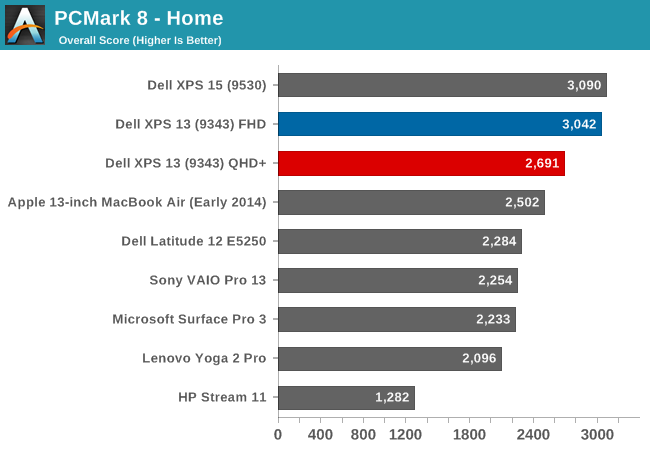
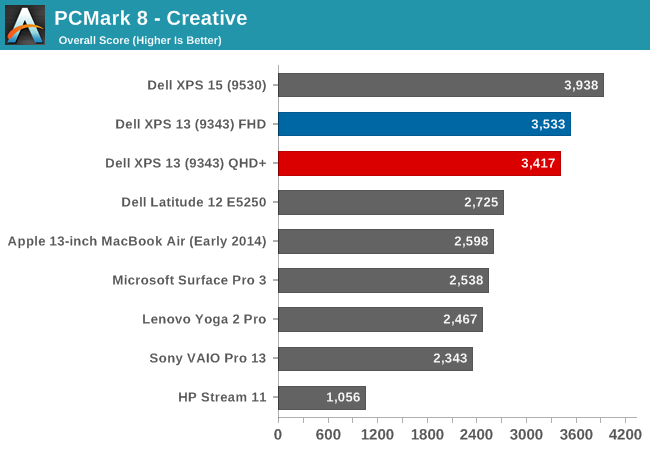
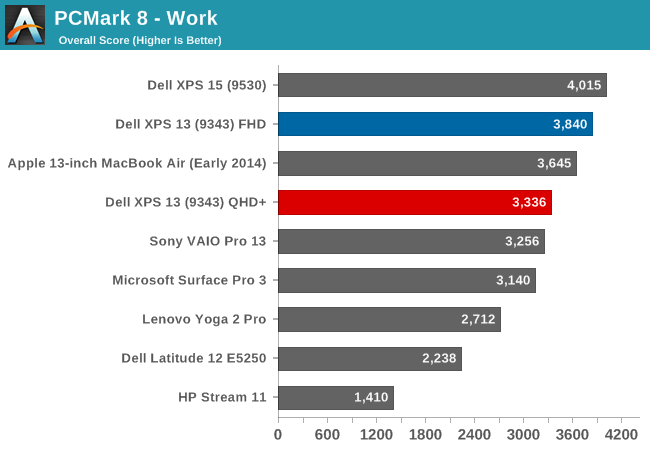
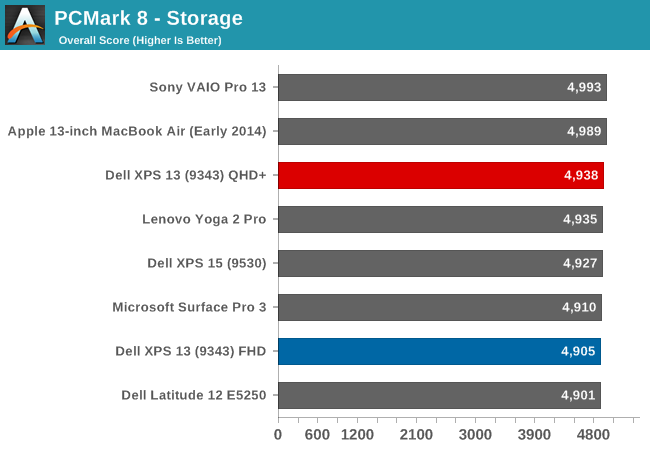
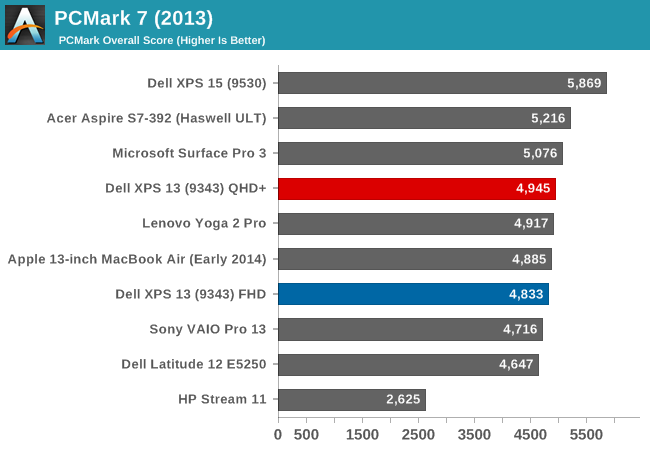
PCMark 8 from Futuremark runs through a variety of tests, and many of the test feature OpenCL support. The Home benchmark runs through what the typical home user would do: web browsing, gaming, and photo editing. Creative is for media and entertainment creation and is more demanding than the Home test. The Work suite tests basic office tasks. The higher resolution model has more work to do on these and scores a bit behind the 1080p model, but overall the new XPS 13 scores quite well on these types of workloads.
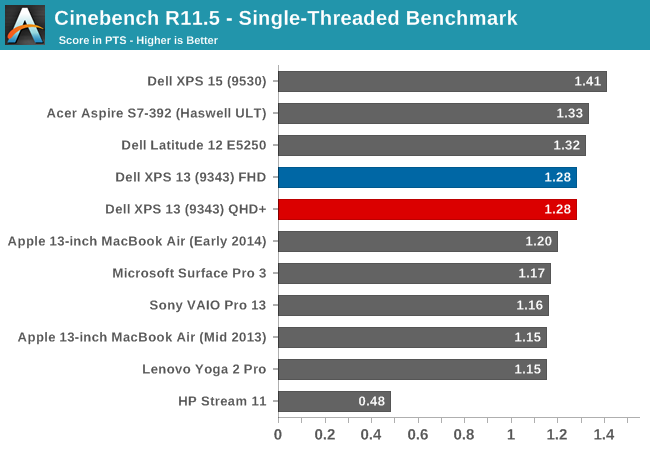

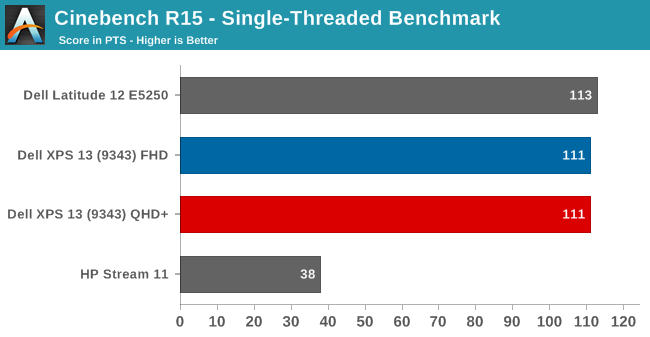
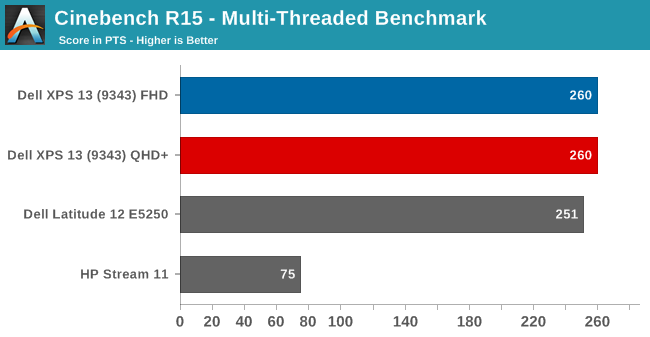
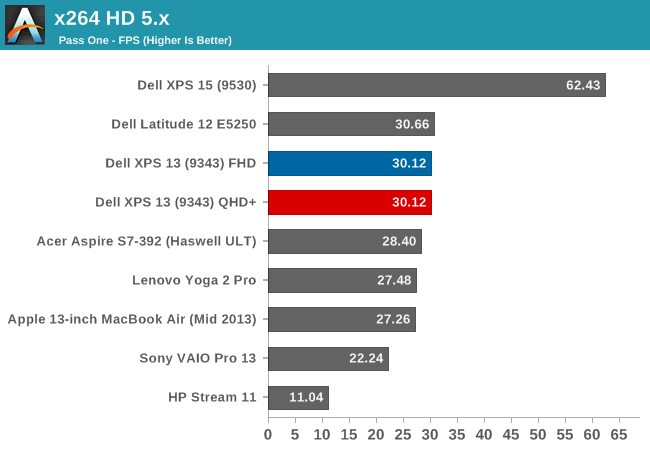
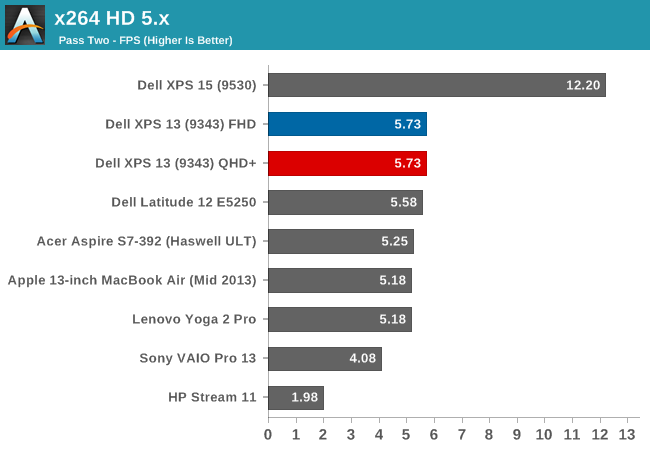
Cinebench tests the CPU's ability to render a scene. Broadwell-U does well here, and though the single core scores show that the i5-5200U is a bit slower than the Acer's i7, and especially the XPS 15 with it's higher TDP part, there is a nice bump up from the i5-4200U in the Lenovo Yoga 2 Pro. Multithreaded is where the new 14nm process can really shine. The lower power usage means that there is more headroom for the CPU to keep the clock speeds higher when all cores are active, and it shows a great result here compared to the Haswell-U series parts. x264 HD also shows favorable results for Broadwell, with the i5-5200U outperforming the old i7-4500U. The Dell XPS 15, with the full quad-core, eight-thread CPU, unsurprisingly outperforms all of the U series CPUs.
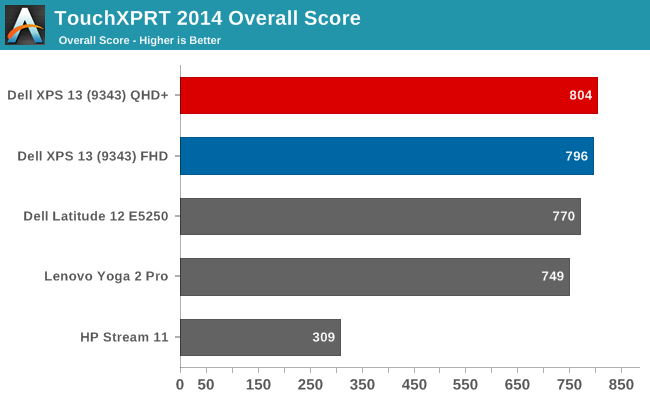
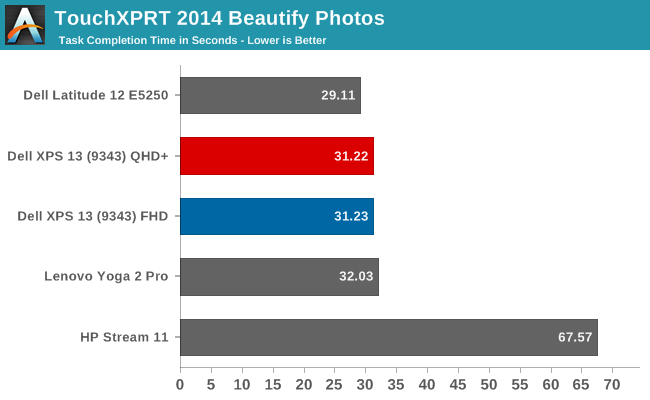
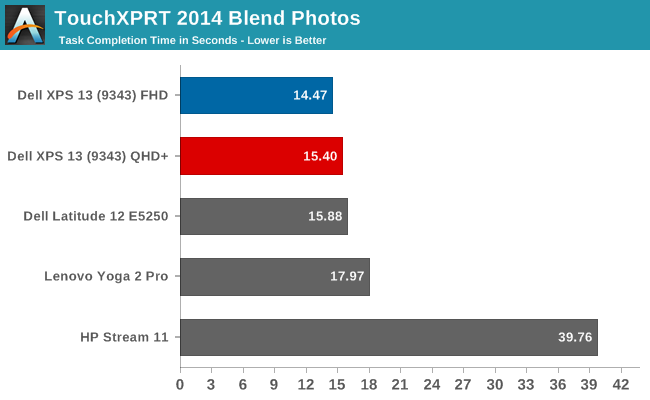
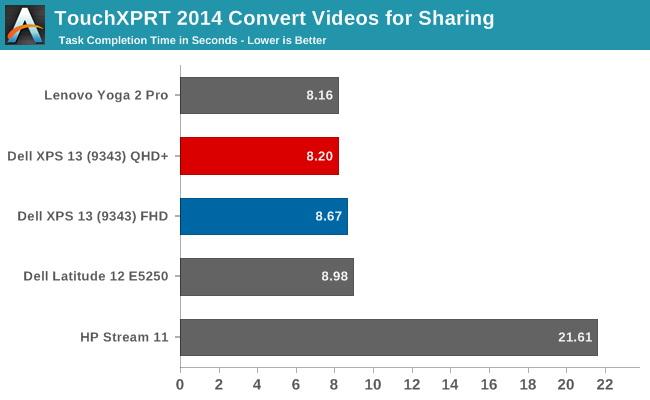
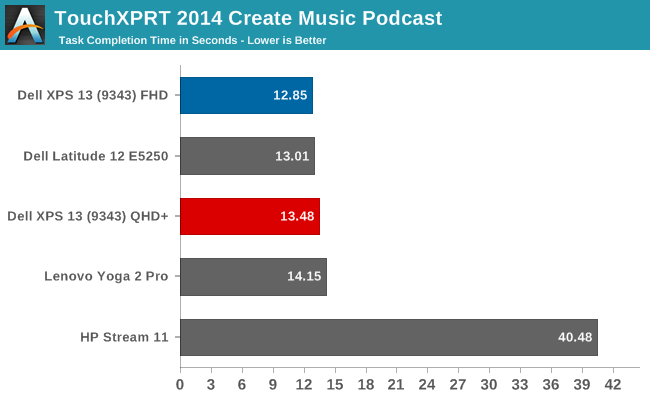

TouchXPRT 2014 is a WinRT app found in the Windows App Store that performs a series of common tasks for a typical home user, and calculates a score based on how quickly the tasks were performed. Here Broadwell seems to perform very similarly to Haswell, with the exception of the video conversion which was quite a bit slower. Update 2015-02-20: Intel has provided us with an updated graphics driver which solves the slow video conversion issue. I have re-run the tests and updated the graphs. If you would like to install this driver from Intel.com, you must first remove the existing one from Programs and Features or you will be blocked from installing, since the version that comes with the device is from Dell.
The Yoga 2 Pro has the Core i5-4200U, and the Dell XPS 13 is the Core i5-5200U, so it makes a good comparison for performance. Overall, the Broadwell based XPS 13 is generally slightly faster than the previous generation processors, but not by much for most single cpu tasks. Multithreaded scenarios show a nice gain in performance with Broadwell just from the ability to keep the clock speeds higher under heavily threaded loads.
As expected, the switch to 14nm did not bring a huge performance change for the CPU, and for that we may have to wait for Skylake, which is the next Tock from Intel (new processor architecture) coming later this year. The Dell XPS 15, with its higher wattage quad-core CPU, shows a clear lead as expected, and the Atom processor in the HP Stream 11 is sorely outclassed.
Interestingly, the FHD model was able to outperform the QHD+ model on a couple of the PCMark 8 tests. I’ve re-ran the benchmarks several times, and these results are consistent. The PCMark tests do include some gaming and other GPU loads which would be slower on the high DPI display.
WiFi
The review units we received both came with the Dell Wireless AC 1560 adapter, which is based on a Broadcom chipset. Originally I had connection issues on 5 GHz with the QHD+ model, but Dell shipped out a driver update which seems to have sorted that, so if you have purchased one of the early model XPS 13s, check Dell’s site for some updates.
Optionally, Dell will outfit the XPS 13 with the Intel Dual Band Wireless-AC 7265 adapter, or the spec sheet also lists the Wireless-N version of this Intel adapter. I have seen and used the AC 7265 on a couple of machines, such as the Dell Latitude 12 E5250, and it performed very well.
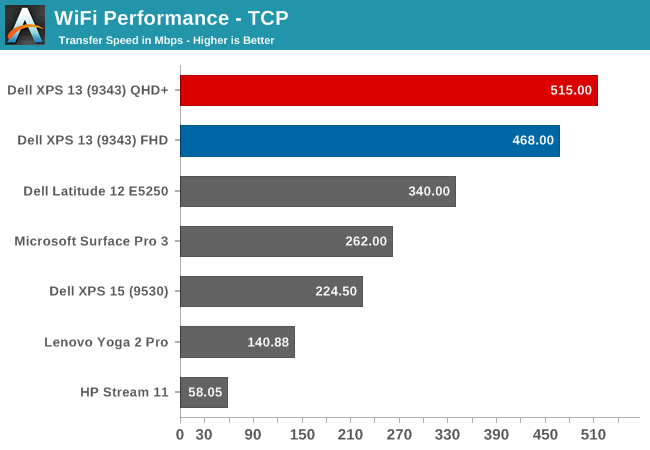
Wireless performance was very good, with the Broadcom chip pulling to the top of the chart. Once the initial connection issues were resolved with the driver update, I had no problems with the wireless connection on the XPS 13.










201 Comments
View All Comments
qasdfdsaq - Friday, February 20, 2015 - link
Apple charge £120 to upgrade from a 1TB drive to a 3TB drive in an iMac 27". These are standard 3.5" desktop drives. The price difference between a 1TB drive and 3TB drive at retail is about £35. £120 may not sound like much but that's still 350% more than free market prices.Then there's the £800 for a 1TB SSD. Market prices are around £350. It's rather irrelevant if you can find a Samsung XP951 cheaper, they do not at any point advertise it being a Samsung XP951.
Even so, a 512GB XP951 costs £340 at retail, whereas the 'Apple cost' for it is around £450. And this is in a 27" iMac that can easily fit two, if not four 2.5" SSDs which would offer comparable storage and performance at less than half the cost - but they don't offer the option. Deliberately offering a very expensive option with no real advantages is the pretty much the definition of price gouging (note that I'm not referring to the US legal definition here)
Synomenon - Thursday, February 19, 2015 - link
So what's gaming performance like b/w the QHD+ and FHD versions if BOTH have 8GB of RAM?Jon Tseng - Thursday, February 19, 2015 - link
Interesting - all credit for testing QHD vs. FHD. I'd seen the other reviews (QHD only) showing mediocre battery life and had been wondering why 14nm was't delivering an improvement!odedia - Thursday, February 19, 2015 - link
I can't believe you published this but still didn't publish the iMac 5k review. Disappointing.Ryan Smith - Thursday, February 19, 2015 - link
To be clear, Brett's job here is to look at laptops and WinPhone devices. The iMac is my task, and what Brett works on has no impact on that.Samus - Thursday, February 19, 2015 - link
Dell's still trying to shake off their poor reputation during the 00's, especially with bomb's like the Inspiron 700mBut this is a solid machine.
piroroadkill - Thursday, February 19, 2015 - link
The Inspirons may have been shite back then, but I recall fondly the Latitudes and Precisions of those days. Chunky beasts, yes, but it was a period when you could get high res screens in a decent chassis. 1400×1050 14", 1920×1200 15", 1600×1200 15".. blah, blah.. Got a D800 that still works fine, with Radeon 9600 GPU. Hot shit for the time.bznotins - Thursday, February 19, 2015 - link
Wow, looks like a really nice laptop. I've always wondered why bezels had to be so large.I'm typing this on a 13" 2013 Retina MBP. Now that Windows is starting to get high dpi scaling into better shape, and vendors like Dell are making nice high-dpi hardware, I might be able to finally come back to the PC world. OSX just isn't that great, and running Windows on a mac isn't that great either.
Steveymoo - Thursday, February 19, 2015 - link
Looks like the laptop to beat for travelling photographers!John_dune - Thursday, February 19, 2015 - link
Brett, there is one question this review has left me, and it seems like a fairly big one... is there any aftermarket upgradability with this device? I currently have an Acer TimelineX 3810 that's almost hitting the end of its life, and i find that i don't really use the dedicated graphics for anything, and I was thinking about upgrading to this laptop. Would i be able for example to upgrade the ram myself to 8gb? or be able to put in a 512gb ssd (i'm assuming it's not a 2.5 inch hdd in there)?